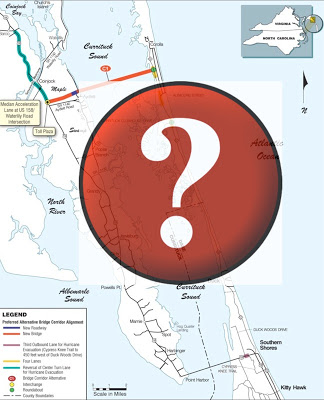The Mid Currituck Bridge has never come this close to breaking ground and suddenly news has come that it may be on the fiscal chopping block.
At an informational luncheon hosted by the Outer Banks Chamber of Commerce last week, NCDOT Division Engineer, Barry Hobbs, Project Manager for the northeastern North Carolina division, indicated the NC assembly may not provide ongoing funds for the project.
No one can be sure of the final outcome. The project enjoys widespread federal and state bipartisan support in eastern North Carolina, but NC house members in central and western districts may not be aware of the traffic nightmare that occurs every weekend in the summer.
The Mid Currituck Bridge is seen as the best means to alleviate the traffic woes that are created in Duck, Southern Shores and southern Currituck County as visitors stream to the Outer Banks in the summer. Bisecting the Currituck Sound, the bridge would connect Aydlett on the mainland–about 18 miles north of the Wright Memorial Bridge–with Corolla.
The project is actually very close to breaking ground. The final Environmental Impact Statement (FEIS) was approved in June of last year, and all that remains to allow bids and start construction, is a Record of Decision (ROD). The ROD was scheduled to be issued in December but at this point in time there is no indication when the document will be issued, and without funding, it is highly unlikely that it would be issued.
There are other factors in play. Carrying a price tag of $600 million, the project, which will be a toll road, is a private/public venture, and the state of North Carolina has very specific financial obligations to keep.
The funding that the state is being asked to provide at this point in time is considered “ bridge” funding–moneys provided to keep the project moving forward. It is not construction money.
Although the private/public partnership is a complex agreement, essentially the private partner will issue bonds underwritten by the state to fund construction. The private company will manage the bridge and repay the bonds from the tolls.
If the state does not meet its financial obligations to its private partners, it is doubtful the partnership will survive.
Given the current fiscal climate in the state legislature and North Carolina’s current financial position, it is difficult to see how this project could go forward without a private partner.
The luncheon also addressed a wide range of ongoing and planned projects on the Outer Banks. The largest project on the horizon is the replacement span for the aging Bonner Bridge over Oregon Inlet connecting Hatteras Island with the norther Outer Banks. That particular project is moving forward very well . . . bids have been accepted and specific plans for construction are almost complete. There is, however, a lawsuit pending that challenges the way in which the FEIS was created. The lawsuit is, “in the judge’s hands,” is according to Hobbs.

